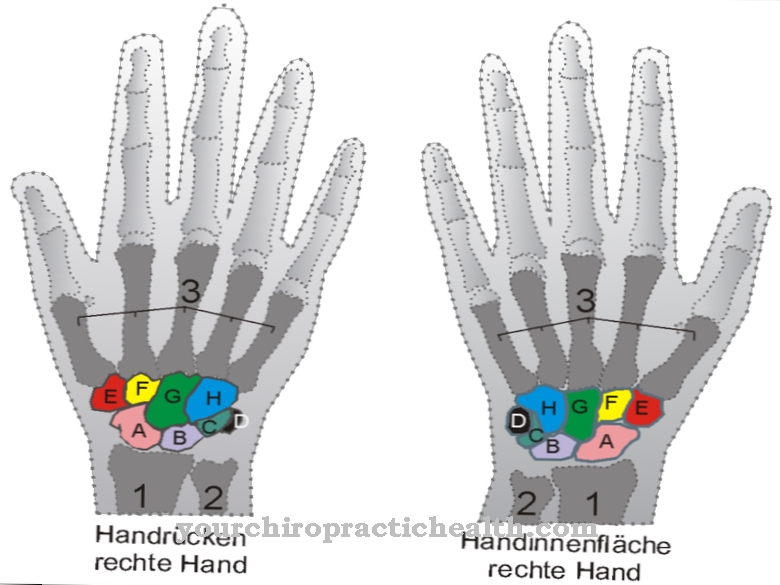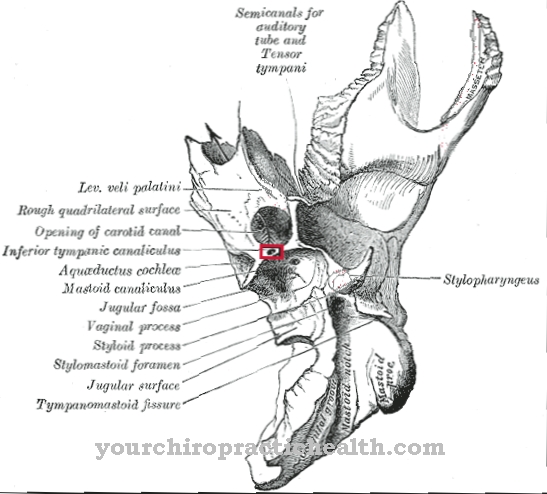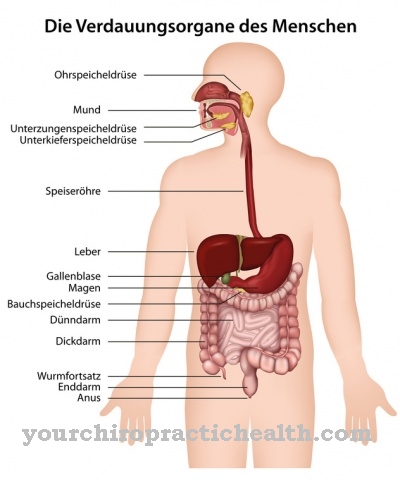The Mesentery refers to a "mesentery" that serves as a hanging strap for the intestine. In a broader sense, all mesenteries of the organs lying within the peritoneum are called mesenteries.
What is the mesentery?
The mesentery is also called mesentery or Meso and is a doubling of the peritoneum, the peritoneum. It functions as a "hanging strap" for the intestine and extends from the posterior abdominal wall. The intestine is partially attached to the mesentery, which enables fixation while at the same time being mobile.
In a broader sense, the term mesentery denotes all mesenteries of the organs located within the peritoneum. In a narrower definition, the mesentery only refers to the mesentery of the small intestine, more precisely the ileum and the jejunum.
Anatomy & structure
The respective intestinal sections are partially suspended from the mesenteries, which ensures that they remain mobile despite a certain degree of fixation. The mesenteries contain lymph vessels, connective and adipose tissue, nerves and vessels to supply the intestines.
The mesentery passes through the intestinal loops into the serosa of the intestine. Attachments of the mesentery remote from the organs are called "mesenteric roots" (radix mesenterii). The visceral and parietal sheets of the peritoneum meet at the radix mesenterii. A mesentery that is stretched between two organs is called a ligament.
There are various mesenteries in the human body, some of which are only present in the embryonic stage and later regress. The mesenteries can be divided into:
- Mesogastrium
The mesogastrium consists of two parts, the ventral mesogastrium and the dorsal mesogastrium. The ventral mesogastrium is the anterior mesentery of the stomach, the ventral mesogastrium is the rear. The mesogastrium develops in the embryonic period and changes into various other structures as the body develops.
The ventral mesogastrium, which exists during the embryonic stage, can in turn be divided into the ventral and dorsal mesohepaticum. The mesohepaticum ventral develops into the ligamentum falciforme hepatis. The mesohepaticum dorsale develops into the omentum minus.
The dorsal mesogastrium, the posterior mesentery of the stomach, develops into the greater omentum as well as the gastrolienal ligament, gastrocolic ligament, gastrophrenic ligament, phrenicolienal ligament and phrenicocolic ligament.
- Mesoduodenum
The mesoduodenum is the mesentery of the duodenum. It develops during the embryonic period. It can be divided into the dorsal mesoduodenum (the posterior mesoduodenum) and the ventral mesoduodenum (the anterior mesoduodenum).
In the mesoduodenum dorsale the pancreas (pancreas) develops. After the embyrional stage, it grows together with the posterior abdominal wall as the duodenum is shifted backwards.
The ventral mesoduodenum, together with the ventral mesogastrium, becomes the lesser omentum, which can be divided into the hepatogastric ligament and the hepatoduodenal ligament.
- Mesojejunum
The mesojejunum is the mesentery of the jejunum. It is attached to the posterior abdominal wall together with the mesoileum. The arteriae jejunales and the venae jejunales from the arteria mesenterica superior and from the vena mesenterica superior, as well as nerve fibers and lymph vessels, which supply the small intestine, run in the mesojejunum.
- Mesoileum
The mesoileum is the mesentery of the ileum. It is attached to the posterior abdominal wall together with the mesentery of the jejunum (mesojejunum). The attachment point is called the radix mesenterii. In the mesoileum, the ileal arteries and the ileal veins run from the superior mesenteric artery and the superior mesenteric vein, as well as nerve fibers and lymph vessels that supply the ileum.
- Mesorectum
The mesorectum is the mesentery of the rectum (rectum). It connects the rectum with the sacrum (sacrum).
There is also the mesocolon, which can be divided into:
- Transverse mesocolon
The transverse mesocolon is the mesentery of the transverse colon, the middle part of the colon. Together with the gastrocolic ligament, it forms the inferior recess of the omental bursa.
- Mesocolon sigmoideum
The mesocolon sigmoideum is the mesentery of the colon sigmoideum (sigmoid). It forms the intersigmoid recess above the left psoas major muscle. Overall, it is very mobile, but is fixed at the transition points to the rectum and the descending colon.
- Mesoappendix
The mesoappendix is the mesentery of the appendix vermiformis, the appendix. The mesoappendix is a peritoneum duplication and can extend to the tip of the appendix. It connects the appendix with the ileum. It also contains the appendix artery, the appendicular vein, as well as lymph vessels and nerves.
Function & tasks
The mesentery as a generic term stands for a "mesentery" that forms the hanging strap of the intestine. It guarantees the fixation of the intestine with simultaneous mobility. The other functions of the various mesenteries can be briefly summarized by the fact that nerves, lymph vessels and vessels run through them, which supply the respective organs. In particular, the exact function and task of the mesentery is related to the organ being supplied.
You can find your medication here
➔ Medicines for stomach ailments and painDiseases
In connection with the mesentery, a so-called volvulus, a rotation of a section of the digestive tract around its mesenteric axis, is conceivable as a possible complaint or disease. This rotation restricts the blood supply to the affected section, which runs over the mesentery. Intestinal obstruction and the destruction of intestinal tissue (intestinal gangrene) are possible. The acute volvulus is a surgical emergency.
Furthermore, anatomical malformations of the mesenteries and damage to the mesenteries due to external influences, e.g. possible through gunshot or stab wounds.


.jpg)









.jpg)



.jpg)










.jpg)
